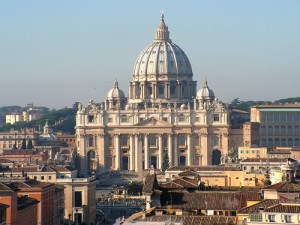 Carol Ann mentioned Melissa Wilde’s book on Vatican II, and I think it is a hugely important book in the Sociology of Religion, and one well worth exploring in more detail on this blog. Below is a short excerpt from my own part in an Authors Meets Critics Session for the book held almost 5 years ago:
Carol Ann mentioned Melissa Wilde’s book on Vatican II, and I think it is a hugely important book in the Sociology of Religion, and one well worth exploring in more detail on this blog. Below is a short excerpt from my own part in an Authors Meets Critics Session for the book held almost 5 years ago:
“With Vatican II: A Sociological Analysis of Religious Change, Melissa Wilde has written a book that people will want to read, and it is a book that should be read. Writing in the kind of prose, that so many of us wish we could write but so few of us can, she outlines a simple, elegant argument for understanding why Vatican II changed some things and not others, and also why it changed anything at all.
Melissa begins her book by outlining why there was any change at all. She argues that early on in Vatican II a series of occurrences made it into an “event” in which there was a durable change of structures. This change was not pre-determined. In fact, she shows that the obstacles to change of any progressive sort were immense. Conservative forces in the Roman curia had engaged in “agenda setting” for two entire years prior to the council seeking to limit the scope of change, suggesting a formidable set of obstacles to overcome. Yet, overcome them the Bishops did. Below is Melissa Wilde’s narrative of the key occurrences that turned Vatican II into an event.
Vatican II as an “Event”
Initially, most Bishops expected Vatican II to be a rubber-stamp council and the prepared schemas were very conservative. On the first day of the Council, however, Cardinal Leinhart, instead of “following the script,” dramatically took the microphone and asked that the vote on conciliar commissions be delayed, despite this being “out of order.” Cardinal Frings quickly seconded his motion and the council erupted in applause. Both Cardinals felt that bishops needed time to get more familiar with candidates before voting on commissions. Importantly, Leinhart asked that the episcopal conferences be given the task of creating new lists of nominees. Thus, individual Bishops became much more engaged in the actual nominating and voting process and an alternative institutional apparatus (episcopal conferences), rather than the Roman curia (i.e., the Vatican bureaucracy) were put in charge of structuring choices.
Second, progressives successfully moved up a vote on the schema on liturgy. While it was listed fifth in the preparatory documents, progressives quickly set about making sure that liturgy became the first issue addressed by the Council. This schema was considered the most progressive draft (or at least the “least problematic” from the viewpoint of progressives) in large part because the commission that prepared it was the only one that was not dominated by members of the curia. Despite significant resistance from conservatives, the draft schema on liturgy passed with overwhelming support toward the middle of the first session and was the first schema ratified by the Council.
The third and final occurrence emphasized by Wilde was when the schema on revelation was defeated. This occurrence showed that the council could actually reject, not just amend a schema, and it meant that the Bishops could in fact alter the outcome of Vatican II.
As a consequence of these series of occurrences, people involved in the Council began to believe that real change was possible, and they began to describe a powerful sense that the Holy Spirit was moving in the Church. Melissa Wilde identified these feelings as an example of collective effervescence. Durkheim defined collective effervescence as an emotional intensity that occurs when people “believe they have been swept up into a world entirely different from the one they have before their eyes.” Collective effervescence alters people’s frame of mind and shifts their horizon for what is possible. For Vatican II participants, recognition of the Holy Spirit at work in the Council was experienced with an emotional intensity that overwhelmed them, and it transformed their sense of what was possible. And, consequently, Vatican II transformed the Church.”